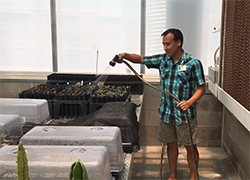The Garden has found a way to extend the benefits of rainy seasons long after the clouds have departed – elevating its rainwater harvesting efforts.
Incorporated in the design for the Hazel Hare Center for Plant Science is an extensive rainwater harvesting system to capture water from the roof of Greenhouse West. Raul Puente-Martinez, curator of Living Collections and research botanist at Desert Botanical Garden, developed a cistern system and with help from coLAB and 180degrees as co-designer and general contractor, the system came to life with a combination of troughs, gutters and downspouts. During a storm, rainwater flows into two large cisterns, located on the north side of the Greenhouse, that can hold 2,800 gallons of water.
“Rainwater is far superior to tap water because it is as clean of water as you can get. Even the canal water we use for most of our irrigation, and is better than tap water for plants, has minerals in it that can have negative effects on our most sensitive plants,” says Dr. Kimberlie McCue, senior director of desert horticulture and conservation. “Seedlings are the most sensitive to salt stress, and in the past we could see salt build-up on the top of the soil of our seedlings. Using rainwater circumvents this and is the healthiest thing we can use for these plants.”
Connected to the greenhouse cisterns are two hose bibs, one outside and one in the north bay of Greenhouse West. Desert horticulture and conservation staff are able to use the rainwater to water seedlings, rare and endangered plants, as well as other plants in the collection.
The cistern system is the most obvious rainwater harvesting element at the Garden, but rainwater harvesting has been in place here for years. In the main parking lot and in multiple other locations, bio-retention basins have been created to reduce flooding, allow rainwater time to percolate down into the soil and create a filtration system to remove the oil and build-up that can mix with rainwater in a parking lot.
“Technically it is water harvesting because we are capturing it for a specific purpose. Conserving water, in any way, is important to the Garden’s mission and has been part of a long-term conservation plan,” says McCue. 
See the cistern system and learn more about the Garden’s rainwater harvesting benefits by attending a Behind-The-Scenes Tour of the Hazel Hare Center for Plant Science this fall.
